Themes
Proposals are welcomed on, but not limited to, the following themes:
| Main Theme | Topics | Potential Themes |
| 1. Geospatial Technologies Applied to the Humanities | GIS and spatial analysis, including 3D modelling and spatial statistics | Data mining and visualization; challenges of geolocation; Spatiotemporal modeling (diachronic GIS, dynamic landscapes); Embodied mapping (linking computational models to human or robotic spatial experience); GIS applications in historical cartography. |
| 2. Methodological Innovation and Computational Approaches | Artificial intelligence (computer vision, NLP, deep learning); laboratory notebooks, workflows, and infrastructure. | Pedagogical uses of methods (e.g., spatial literacy, teaching AI/GIS); Ethical reflections on algorithmic mapping and automation; Integration of quantitative and qualitative data. |
| 3. Heritage and Spatial History | Construction, mapping, and spatial analysis of heritage inventories; historical cartography and georeferencing | Temporal reconstruction (spatial change over time); Heritage participation (community mapping); geographic representation and analysis of monuments, memory sites, and heritage linked to conflict contexts; FAIR/CARE protocols for heritage repositories; Study of historical urban networks and infrastructures; Digitization, modelling, and virtual reconstruction of historical urban centers. |
| 4. Spatialized Narratives, Mobility, and Networks | Spatial explorations of narratives, literary and imaginary places; mapping mobility, spatial connections, and networks | Multimodal storymapping (text-image-sound) and narrative curation; Map-text linkage (mixed-method approaches); Embodied and experiential narratives (e.g., phenomenological or sensory mapping of movement in space); Spatial exploration of literary and artistic expressions; Analysis of mobility dynamics, transport systems, and flows of people, goods, and knowledge. |
| 5. Spatial Data, Digital Collections, and Infrastructure | “Collections as Data” in a geospatial context; Linked (Geo)Open Data; IIIF applications for maps and spatial data | Integration and analysis of spatial data in digital platforms; Infrastructures for sharing and preserving geographic data; Interactive visualization of maps and heritage data; Semantic linking of spatial data with open technologies; Geographic exploration of spatial patterns in digital collections. |
| 6. Environmental Humanities, Landscape Studies and Sustainability | Environmental humanities: landscapes, waters, and blue humanities | Temporal environmental change (e.g., climate or landscape evolution); Participatory/affective environmental mapping; ecosystems and societies. Land-use mapping and environmental impact; Cartographies of rivers, coastal zones, and inland waters; Climate representations and environmental memory; Analysis of natural risks and vulnerabilities. Blue and green humanities and participatory indicators; Urban ecology and nature in the city. |
| 7. Education, Digital Literacy, and Scientific Dissemination | GIS and digital humanities in education; methodologies of spatial and digital literacy | Pedagogical use of geospatial platforms. Integration of spatial humanities into teaching; Community engagement in interactive and participatory mapping. |
| 8. History and Study of Social Phenomena | Georeferencing and spatial analysis of social and historical phenomena (migration, poverty, child abandonment, urbanization) | Spatial distribution and inequalities of institutions, social classes, and services; Urban history and social morphology; Integration of historical databases and GIS; Historical big data and quantitative methods applied to spatial humanities. |
| 9. Spatial Cognition and Representation of Space | Spatial thinking in social sciences and humanities; perceptions and representations of urban, rural, and historical space | Cartography, interactive visualization, and digital representation of space; Relationships between technology, cognition, and human spatial experience; Perceived and lived space in cultural narratives. |
| 10. Urban Space and Mobility | Urban morphologies, spatial segregation, and inequalities; urbanism and mobility | Public policies and planning from historical and social perspectives; Spatial and social analysis of the built environment; Infrastructure networks and urban transformation and evolution. |
| 11. Interdisciplinarity and Integration in Spatial Humanities | Interface between geography, history, literature, archaeology, and heritage | Collaborative methodologies and practices; Creation of shared digital platforms; Living labs and cross-disciplinary interoperability. Spatial humanities as a bridge between human, social, and computational sciences. |
